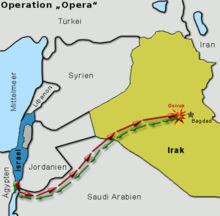Operation Opera
Coordinates: 33 ° 12 ′ 30 ″ N , 44 ° 31 ′ 30 ″ E
The operation Opera was an Israeli air strike on June 7, 1981 to the Iraqi nuclear reactor Tammuz-1 ( Osirak ).
prehistory
The Israeli government was concerned about the 1975 nuclear deal between France and Iraq. In addition to the nuclear race in the Middle East, there was a threat of a nuclear threat from Iraq. The Tammuz-1 reactor is said to have been able to produce plutonium in the long term. The Iranian government was equally concerned about Iraq's nuclear potential with the First Gulf War that had just begun . The Iranian Operation Scorch Sword , an air strike on the Tammuz-1 reactor on October 30, 1980, was a failure. Since the destruction of the reactor before it is filled with fuel rods had to be done to make a Fallout avoid, Israel was under time pressure. In addition, Israeli Prime Minister Menachem Begin feared that the next elected government would not approve an attack.
preparation
The IAF made the first plans as early as February 1980 . The great distance and the overflight over various (hostile) countries were problematic. In the first draft, the attack with Douglas A-4 aircraft was planned, which were to be refueled in the air from C-130s . In July 1980, the IAF received F-16 aircraft - an order originally intended by the US for the Iranian Air Force and canceled due to the Islamic Revolution . Now the preparations - additional tanks and target approaches - were carried out with these aircraft.
attack
On June 7, 1981 started at 15:50 eight F-16 - a fighter-bomber and a fighter escort of six F-15 the Israeli Air Force by the then Israeli base Etzion on the Sinai , flew about 1,100 km at an altitude of 90-150 meters above Jordanian and the Saudi Arabian border area. In order to deceive the Iraqi air defense, the pilots spoke Arabic. The first attack on the reactor was flown around 17:31. The operation was completed in two minutes. 14 of a total of 16 Mark 84 bombs hit the reactor building directly. The reactor building was destroyed in the attacks; eleven people died, including a French technician. According to a description by Victor Ostrovsky in the book The Mossad , he secretly worked for the Israeli secret service and had a target transmitter deposited in the reactor. But why he had not left the facility could not be clarified. At 6:40 p.m., all Israeli aircraft landed undamaged on the Etzion base.
Among the pilots who formed the end of the attack formation was the future spaceman Ilan Ramon . He later reported heavy smoke from inside the reactor as well as a huge explosion, which did not, however, lead to the collapse of the building.
consequences
The United Nations Security Council condemned Israel's actions in Resolution 487 (1981). Politically, the military attack was a serious failure. “Arab states that had previously fallen out with one another, such as Syria and Iraq, promptly made a new attempt to come to an agreement against their common enemy Israel.” Militarily, however, the attack was a resounding success. The machines returned to Israel with no losses and, whether there was an Iraqi nuclear weapons program or not, it was now certain from the Israeli perspective that Israel would remain the only nuclear power in the region. At the same time it was a renewed demonstration of Israeli superiority and a clear message to the surrounding countries that Israel was not ready to tolerate nuclear weapons programs.
Remarks
-
↑ Israel suspected a masked nuclear weapons program. France promised to prevent the critical quantity through short delivery times and controls. See: Joshua Kirschenbaum ( May 18, 2015 memento in the Internet Archive ).
Iraqi scientists are said to have assumed that they could produce 2 kg of plutonium per year with Tammuz-1 . See: David Albright ( December 21, 2012 memento on the Internet Archive ).
The interpretation of Tammuz-1 speaks against this, which with 25 kg of highly enriched uranium would only produce an amount of plutonium in the gram range at full load. The reactor is transparent . In: Der Spiegel . No. 25 , 1981 ( online ). - ↑ Tammuz-1 should go into operation in September 1981. See: Jacqueline Denis-Lempereur ( Memento of December 11, 2012 in the Internet Archive )
- ↑ For Menachem Begin, a survivor of the Holocaust , Saddam Hussein was Hitler and "the Osirak reactor was the most technologically advanced implementation of the Final Solution." See: au.af.mil ( Memento of December 31, 2012 in the Internet Archive )
- ↑ Damien Chaussepied. See: nytimes.com ( Memento of November 7, 2012 in the Internet Archive )
literature
- Amos Perlmutter, Uri Bar-Joseph, Michael I. Handel: Two Minutes Over Baghdad. Routledge Chapman & Hall, 2003, ISBN 978-0-7146-8347-8 .
Web links
- youtube original recordings of the IAF
- Osirak: Over the reactor . BBC
Individual evidence
- ↑ Perlmutter et al.
- ^ Thirty Years Since the Bombing of the Iraqi Reactor.
- ↑ a b Got crazy? In: Der Spiegel . No. 25 , 1981 ( online ).
- ↑ Perlmutter et al.
- ↑ Tammuz-1 after the attack ( Memento from October 3, 2013 in the Internet Archive )
- ↑ Resolution 487 (1981) ( Memento of March 17, 2013 in the Internet Archive )

